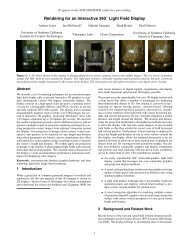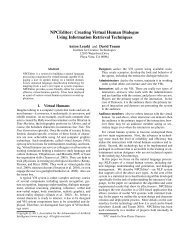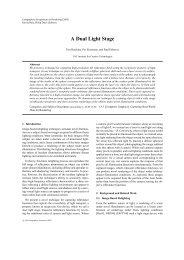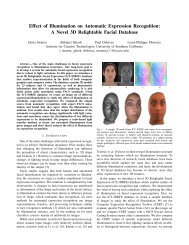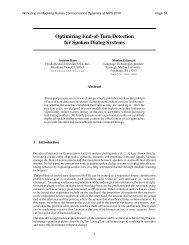EMA: A computational model of appraisal dynamics - University of ...
EMA: A computational model of appraisal dynamics - University of ...
EMA: A computational model of appraisal dynamics - University of ...
You also want an ePaper? Increase the reach of your titles
YUMPU automatically turns print PDFs into web optimized ePapers that Google loves.
Appears in Agent Construction and Emotions, 2006<strong>EMA</strong>: A <strong>computational</strong> <strong>model</strong> <strong>of</strong> <strong>appraisal</strong> <strong>dynamics</strong>Stacy Marsella<strong>University</strong> <strong>of</strong> Southern Californiamarsella@isi.usc.eduJonathan Gratch<strong>University</strong> <strong>of</strong> Southern Californiagratch@ict.usc.eduAbstractA <strong>computational</strong> <strong>model</strong> <strong>of</strong> emotion must explain both the rapid <strong>dynamics</strong> <strong>of</strong> some emotional reactions aswell as the slower responses that follow deliberation. This is <strong>of</strong>ten addressed by positing multiple <strong>appraisal</strong>processes such as fast pattern directed vs. slower deliberative <strong>appraisal</strong>s. In our view, this confuses<strong>appraisal</strong> with inference. Rather, we argue for a single and automatic <strong>appraisal</strong> process that operatesover a person’s interpretation <strong>of</strong> their relationship to the environment. Dynamics arise from perceptualand inferential processes operating on this interpretation (including deliberative and reactive processes).We illustrate this perspective through the <strong>computational</strong> <strong>model</strong>ing <strong>of</strong> a naturalistic emotional situation.1 IntroductionChange is an inherent quality <strong>of</strong> emotion. Aroused byan unpleasant event, a person might explode into anger,fume at a slow boil or collapse into a depression.Once aroused, emotions influence our actions andjudgments concerning the event, altering what Lazarus[1] calls the person-environment relationship. Changesto this relationship can induce new emotional responses,resulting in a cycle <strong>of</strong> change in the person’srelation to the environment. These changes can berapid, on the order <strong>of</strong> milliseconds, or unfold overdays and weeks. In short, emotions are inherently dynamic,linked to both the world’s <strong>dynamics</strong> and the<strong>dynamics</strong> <strong>of</strong> the individual’s physiological, cognitiveand behavioral processes.A key challenge for any theory <strong>of</strong> emotion is to capturethis dynamic emotional process. Over the last 50years <strong>appraisal</strong> theories have been established as aleading theory <strong>of</strong> emotion. These theories argue thatemotion arises from a person’s interpretation <strong>of</strong> theiroverall relationship with the environment as characterizedby a set <strong>of</strong> <strong>appraisal</strong> variables (e.g., is this eventdesirable, who caused it, what power do I have overits unfolding). To date, however, <strong>appraisal</strong> theorieshave largely focused on structural considerations(e.g., specifying the components <strong>of</strong> <strong>appraisal</strong>) [2]. Farless progress has been made in detailing the processesthat underlie <strong>appraisal</strong>, with some notable exceptions.For example, Lazarus proposed a cyclical relationshipbetween <strong>appraisal</strong>, coping and re-<strong>appraisal</strong>. At a finergrain, Scherer’s sequential checking <strong>model</strong> argues forthe sequencing <strong>of</strong> distinct <strong>appraisal</strong> checks (relevance,etc.) that determine the <strong>appraisal</strong> variables [3]. Smithand Kirby argues for a two process <strong>model</strong> <strong>of</strong> <strong>appraisal</strong>whereby associative processing, a memory-basedprocess and reasoning, a slower and more deliberativeprocess, operate in parallel [4]. Moors investigatesautomaticity <strong>of</strong> some <strong>appraisal</strong> processes [5]. Reisenzeinproposed a <strong>model</strong> <strong>of</strong> <strong>appraisal</strong> that distinguishesbetween hardwired <strong>appraisal</strong> processes for some <strong>appraisal</strong>dimensions and peripheral <strong>appraisal</strong>s that canbe deliberative or learned [2].However, further progress is needed if <strong>appraisal</strong>theories are to provide a full account <strong>of</strong> emotionalprocesses and their role in behavior. Specifically, theoriesmust detail the processes by which each <strong>appraisal</strong>variable is determined, including the logical and temporaldependencies between these <strong>appraisal</strong> processes[4]. Additionally, the basic calculus <strong>of</strong> how the results<strong>of</strong> <strong>appraisal</strong> result in emotions <strong>of</strong> varying types, intensitiesand durations must be determined. Completingthe cycle, the impact <strong>of</strong> emotions on coping responsesand subsequent changes in the environment-personrelationship must be detailed.We see <strong>computational</strong> <strong>model</strong>s <strong>of</strong> emotion as a powerfulapproach to concretizing and exploring the dynamicproperties <strong>of</strong> <strong>appraisal</strong>. The construction <strong>of</strong> a<strong>computational</strong> <strong>model</strong> forces specific commitmentsabout how the person-environment relationship is represented,how <strong>appraisal</strong>s are performed on those representations,the role <strong>of</strong> perception, memory, interpretationand inference in <strong>appraisal</strong>, and the relationshipbetween <strong>appraisal</strong>s, emotions and coping responses.Often these commitments raise issues that are unforeseenat more abstract specifications <strong>of</strong> a theory. Further,once <strong>computational</strong>ly realized, simulation allowsthe <strong>model</strong> to be systematically explored and manipulated,thereby generating predictions that can be furthertested with human subjects. Indeed given thecomplexity <strong>of</strong> <strong>appraisal</strong> theories, exploring dynamicproperties <strong>of</strong> a theory and contrasting alternative theoriesfrom a process-based perspective may arguablyhinge on their computer realization.This paper advocates a theoretical stance towardsthe problem <strong>of</strong> capturing emotional dynamic informedboth by the <strong>appraisal</strong> theory <strong>of</strong> Smith and Lazarus [6]and our experience in realizing this theory in a <strong>computational</strong><strong>model</strong> called <strong>EMA</strong> (EMotion and Adaptation).In our view, process theories <strong>of</strong> <strong>appraisal</strong> have con-
Frame 2 Frame 5 Frame 9 Frame 22Frame 60 Frame 80 Frame 272Figure 1flated <strong>appraisal</strong> and inference. Rather, we argue for asingle and automatic <strong>appraisal</strong> process that operates inparallel over a person’s interpretation <strong>of</strong> their relationshipto the environment. Dynamics arises from perceptualand inferential processes operating independentlyover this interpretation (including deliberative andreactive processes). We illustrate this perspective by<strong>model</strong>ing <strong>of</strong> a naturalistic emotional situation in <strong>EMA</strong>.An example <strong>of</strong> emotion <strong>dynamics</strong>.One approach to studying emotion <strong>dynamics</strong> is to useassessment tools that ask a subject to imagine an evolvingsituation and to introspect on their emotional reactions[7]. This approach has in turn been leveraged toevaluate computer-based <strong>model</strong>s <strong>of</strong> emotion [8].However, the focus in this paper is different. Instead<strong>of</strong> a slowly evolving situation, our interest here is inan evocative situation that elicits a wide array <strong>of</strong> emotionalresponses over a short time period. Specifically,we will analyze and <strong>model</strong> a naturalistic emotioninvokingsituation recorded fortuitously during one <strong>of</strong>our lab studies. We were videotaping actors at 30frames per second as part <strong>of</strong> a study on gestures andpostures. In the midst <strong>of</strong> instructing the actors, a pigeonunexpectedly flew in window. Figure 1 revealsthe reactions <strong>of</strong> one <strong>of</strong> the two actors. Although suchunexpected, uncontrolled event makes a rigorousanalysis problematic, this naturalistic setting serveswell to illustrate the rapid <strong>dynamics</strong> that we wouldwant to cover in a process <strong>model</strong> <strong>of</strong> <strong>appraisal</strong>.In the video, the actor holding the umbrella goesthrough a sequence <strong>of</strong> behaviors that suggest the followinginterpretation:• surprise at an unexpected event (frame 2),• fear (12),• an aggressive stance <strong>of</strong> self-protection (13-23),• relaxation (29),• concern for others (29-42), specifically for the birdthat caused the initial negative reaction and, finally,• an active helping strategy (62-80) combined with relaxedfacial features and smiling suggestive <strong>of</strong> relief.The sequence <strong>of</strong> behaviors that suggest that interpretationis as follows. By frame 2 (F2), the actor has begun to turnand orient toward the sound <strong>of</strong> the bird. Her eyebrowsrise (F3 through F4). The eyebrows return to a more neutrallevel and the mouth begins to open by F8. The Eyebrowslower and the jaw then drops during F11 and F12.In F13, she begins to grab the umbrella at the base, movethe left foot back away from bird and starts to raise arms.She raises the umbrella (F14 through F22), shifting her
weight to her right, rear foot away from the bird. Herposture and grasp <strong>of</strong> the umbrella suggests she is preparedto ward <strong>of</strong>f a presumed attack <strong>of</strong> the bird bywhacking it with the umbrella. She continues her backwardmotion. Her motions slow and by F29 her left handstarts to let go <strong>of</strong> the umbrella and move towards hermouth. The umbrella is lowered in F34 and her left handcovers her mouth by frame F42. By F62 the backwardmotion stops (she moves approximately 6 feet) and theleft hand begins to lower from covering her mouth. ByF66, the actor begins to move forward and the hand lowerssufficiently to reveal relaxed facial features. In F72through F80, the forward motion continues, the handforms into a stop gesture and the face appears to be smiling(laughter and utterances expressing concern for thebird are also heard).A seemingly identical sequence <strong>of</strong> reactions is visiblein the other actor: raised eyebrows, lowered eyebrowsand jaw drop, followed by expressions suggestingrelief/amusement and compassion. But reactionsalso differ, for she becomes aware <strong>of</strong> the bird later, sheis closer to the threat and certain responses are notfacilitated by the instrumentality <strong>of</strong> the umbrella.This rapid transition in the actor’s expressive stateand behaviors lasts 2.6 seconds. The expression <strong>of</strong>raised eyebrows <strong>of</strong>ten associated with surprise takeson the order 30-60 milliseconds and the expression <strong>of</strong>lowered eyebrows and lowered jaw <strong>of</strong>ten associatedwith anger and responses to threat takes on the order300 milliseconds. Overall, this suggests an interestingprogression from an <strong>appraisal</strong> <strong>of</strong> unexpectedness, to anassessment <strong>of</strong> personal significance, and finally an<strong>appraisal</strong> <strong>of</strong> significance to others (cf. Scherer’s sequentialchecking, [3]). Tightly coupled with these<strong>appraisal</strong> <strong>dynamics</strong> from threat-to-self to threat-tootherand emotion <strong>dynamics</strong> <strong>of</strong> Fear/Anger to Compassion/Relief,there is a corresponding progression <strong>of</strong>coping responses from defend/attack to help.Several factors can help us explain these <strong>dynamics</strong>.The process <strong>of</strong> appraising the situation in terms <strong>of</strong> itsunexpectedness, congruency with the actor’s concerns,etc. can have its own internal <strong>dynamics</strong> grounded insuch factors as inferential demands that underlie the<strong>appraisal</strong> and/or potential logical ordering relationsbetween steps <strong>of</strong> the <strong>appraisal</strong>. As Scherer’s theory <strong>of</strong><strong>appraisal</strong> checks argues, there may be a temporalcourse to the <strong>appraisal</strong> process. There are also perceptualprocesses and inferential processes that alter theactor’s interpretation <strong>of</strong> the situation <strong>appraisal</strong>. Similarlythere are the processes <strong>of</strong> forming a coping responseor plan to deal with the event. Finally, thesituation and subsequent re-<strong>appraisal</strong>s occur due tochanges as the event unfolds. This unfolding occursboth due to the actor’s response <strong>of</strong> “arming herself”and moving away from the event as well as other entitiesbecoming the focus (such as the threat to the bird).Basic Theoretical AssumptionsA central tenant in cognitive <strong>appraisal</strong> theories in general,and Smith and Lazarus’ work in particular, is that <strong>appraisal</strong>and coping center around a person’s interpretation<strong>of</strong> their relationship with the environment. This interpretationis constructed by cognitive processes, summarizedby <strong>appraisal</strong> variables and altered by coping responses.The goal <strong>of</strong> our work is to develop a process<strong>model</strong> <strong>of</strong> <strong>appraisal</strong>, realized as a <strong>computational</strong> process.In our view, there are several key challenges for a<strong>computational</strong> <strong>model</strong> <strong>of</strong> <strong>appraisal</strong>. The <strong>model</strong> mustexplain both the rapid <strong>dynamics</strong> <strong>of</strong> some emotionalreactions as well as the slower evolution <strong>of</strong> emotionalresponses that may follow some deliberation and inferences.The <strong>appraisal</strong> processes must in some way beconsistent with both these reactive and deliberativeresponses. In addition, <strong>appraisal</strong> processes must operateover a range <strong>of</strong> phenomena spanning simple physicalphenomena as well as complex social situations.These challenges are <strong>of</strong>ten addressed by presumingmultiple <strong>appraisal</strong> processes, for example fast patterndirected <strong>appraisal</strong> processes and slower more deliberative<strong>appraisal</strong>s (e.g., [2, 4, 5]). Our theoretical stanceon this issue differs considerably.First and foremost, we cleanly delineate between<strong>appraisal</strong> and inference. We argue that <strong>appraisal</strong> processesare always fast (reactive), parallel and unique inthe sense that we postulate a single process for each<strong>appraisal</strong> variable. However, multiple other perceptualand cognitive processes perform inference (both fastand slow, both deliberative and reactive) over the interpretation<strong>of</strong> the person-environment relationship. Asthose inference processes change the interpretation,they indirectly trigger automatic re<strong>appraisal</strong>.Thus, debates about which emotions have a cognitiveor non-cognitive basis become moot. The relationbetween cognition and <strong>appraisal</strong> is that <strong>appraisal</strong>s operateon the results <strong>of</strong> cognitive operations as well asany other operation that transforms the person’s interpretation<strong>of</strong> their relationship to the environment.A <strong>computational</strong> <strong>model</strong> <strong>of</strong> <strong>appraisal</strong><strong>EMA</strong> is a <strong>computational</strong> <strong>model</strong> that realizes this theoreticalstance. We now sketch the basic outlines <strong>of</strong> the <strong>model</strong>(See [9] for a more complete description.) In generalterms, we characterize a <strong>computational</strong> <strong>model</strong> as a processor processes operating on representations. A <strong>computational</strong><strong>model</strong> <strong>of</strong> <strong>appraisal</strong> is a set <strong>of</strong> processes that interpretand manipulate a representation <strong>of</strong> the personenvironmentrelationship.In our view, a core requirement for the representation<strong>of</strong> the person-environment relation is that it supportthe derivation <strong>of</strong> <strong>appraisal</strong> variables. Moreover, aswe argue that <strong>appraisal</strong> is fast and uniform, the representationmust facilitate that assessment over the range<strong>of</strong> phenomena that induce emotional reactions.To address those requirements, <strong>EMA</strong> uses a representationbuilt on the causal representations developedfor decision-theoretic planning augmented by explicitrepresentation <strong>of</strong> intentions and beliefs (necessary forsocial attributions). The <strong>appraisal</strong> <strong>of</strong> relevance can be
expressed by a plan representation’s ability to expressthe causal relationship between events and states.These causal representations are also critical for assessingcausal attributions necessary for appraisingblame or credit-worthiness. Appraisal variables <strong>of</strong> desirabilityand likelihood can be <strong>model</strong>ed by the decision-theoreticconcepts <strong>of</strong> utility and probability. Explicitrepresentations <strong>of</strong> intentions and beliefs are alsocritical for properly reasoning about causal attributions,as these involve reasoning if the causal agentintended or foresaw the consequences <strong>of</strong> their actions.The commitments to beliefs and intentions also play arole in <strong>model</strong>ing coping strategies, especially what is<strong>of</strong>ten called emotion-focused coping.We call the agent’s interpretation <strong>of</strong> its “agentenvironmentrelationship” the causal interpretation. Itprovides a uniform, explicit representation <strong>of</strong> theagent’s beliefs, desires, intentions, plans and probabilitiesthat allows uniform, fast <strong>appraisal</strong> processes,regardless <strong>of</strong> differences in the underlying phenomenabeing appraised. In the terminology <strong>of</strong> Smith andLazarus, the causal interpretation is a declarative representation<strong>of</strong> the current construal <strong>of</strong> the personenvironmentrelationship.Reactive and more deliberative processes map theirresults into this uniform representation. Architecturally,this is achieved by a blackboard-style <strong>model</strong>. Thecausal interpretation (corresponding to the agent’sworking memory) encodes the input, intermediate resultsand output <strong>of</strong> reasoning processes that mediatebetween the agent’s goals and its physical and socialenvironment (e.g., perception, planning, explanation,and natural language processing). At any point in time,the causal interpretation represents the agent’s currentview <strong>of</strong> the agent-environment relationship, whichchanges with further observation or inference. Wetreat <strong>appraisal</strong> as a set <strong>of</strong> feature detectors that mapfeatures <strong>of</strong> the causal interpretation into <strong>appraisal</strong>variables. For example, an effect that threatens a desiredgoal is assessed as a potential undesirable event.Events are characterized in terms <strong>of</strong> <strong>appraisal</strong> variablesvia domain-independent functions that examinethe syntactic structure <strong>of</strong> the causal interpretation:• Perspective: viewpoint that the event judged• Desirability: what is the utility (positive or negative)<strong>of</strong> the event if it comes to pass, from the perspectivetaken (e.g., does it causally advance or inhibit a state<strong>of</strong> some utility). The utility <strong>of</strong> a state may be intrinsic(agent X attributes utility Y to state Z) or derived(state Z is a precondition <strong>of</strong> a plan that, with somelikelihood, will achieve an end with intrinsic utility).• Likelihood: how probable is the outcome <strong>of</strong> theevent, derived from the decision-theoretic plan.• Causal attribution: who deserves credit/blame. Thisdepends on what agent was responsible for executingthe action, but may also involve considerations <strong>of</strong> intention,foreknowledge and coercion (see [10]).• Temporal status: is this past, present, or future• Controllability: can the outcome be altered by actionsunder control <strong>of</strong> the agent whose perspective istaken. This is derived by looking for actions in thecausal interpretation that could establish or blocksome effect, and that are under the control <strong>of</strong> theagent who’s perspective is being judged (i.e, agent Xcould execute the action).• Changeability: can the outcome be altered by someother causal agent.Each appraised event is mapped to an emotion instance<strong>of</strong> a type and intensity following the structural schemeproposed by Ortony et al. [11]. A simple activation-basedfocus <strong>of</strong> attention <strong>model</strong> computes a current emotionalstate based on most recently accessed emotion instances.Another key aspect <strong>of</strong> <strong>EMA</strong> is that it includes a<strong>computational</strong> <strong>model</strong> <strong>of</strong> coping integrated with the<strong>appraisal</strong> process (according to Lazarus’s theory).Coping determines how one responds to the appraisedsignificance <strong>of</strong> events. Coping strategies are proposedto maintain desirable or overturn undesirable in-focusemotion instances. Coping strategies essentially workin the reverse direction <strong>of</strong> <strong>appraisal</strong>, identifying theprecursors <strong>of</strong> emotion in the causal interpretation thatshould be maintained or altered (e.g., beliefs, desires,intentions and expectations). Strategies include:• Action: select an action for execution• Planning: form an intention to perform some act (theplanner uses intentions to drive its plan generation)• Seek instrumental support: ask someone that is incontrol <strong>of</strong> an outcome for help• Procrastination: wait for an external event to changethe current circumstances• Positive reinterpretation: increase utility <strong>of</strong> positiveside-effect <strong>of</strong> an act with a negative outcome• Acceptance: drop a threatened intention• Denial: lower the probability <strong>of</strong> a pending undesirableoutcome• Mental disengagement: lower utility <strong>of</strong> desired state• Shift blame: shift responsibility for an action towardsome other agent• Seek/suppress information: form positive or negativeintention to monitor a pending or unknown stateStrategies give input to the cognitive processes that actuallyexecute these directives. For example, planful copinggenerates an intention to act, which in turn leads to theplanning system to generate and execute a valid plan toaccomplish this act. Alternatively, coping strategiesmight abandon the goal, lower the goal’s importance, orre-assess who is to blame.Not every strategy applies to a stressor (e.g., an agentcannot be problem directed if it is unaware <strong>of</strong> actionsimpacting the situation), but multiple strategies can apply.<strong>EMA</strong> proposes strategies in parallel but adopts themsequentially. A set <strong>of</strong> preferences resolve ties: e.g., <strong>EMA</strong>prefers problem directed strategies if control is appraisedas high (take action, plan, seek information), procrastinationif changeability is high, and emotion-focus strategiesif control and changeability are low.
Figure 2: The causal interpretation at time t 4In developing a <strong>computational</strong> <strong>model</strong> <strong>of</strong> coping, wehave moved away from broad distinctions <strong>of</strong> problemfocusedand emotion-focused strategies. Formally representingcoping requires a crispness lacking from theproblem-focused/emotion-focused distinction. In particular,much <strong>of</strong> what counts as problem-focused copingin the clinical literature is really inner-directed in aemotion-focused sense. For example, one might forman intention to achieve a desired state – and feel betteras a consequence – without ever acting on the intention.Thus, by performing cognitive acts like planning,one can improve ones interpretation <strong>of</strong> circumstanceswithout actually changing the physical environment.To summarize, an agent’s causal interpretation isequated with the output and intermediate results <strong>of</strong>processes that relate the agent to its physical and socialenvironment. This configuration <strong>of</strong> beliefs, desires,plans, and intentions represents the agent’s currentview <strong>of</strong> the agent-environment relationship, whichmay subsequently change with further observation orinference. We treat <strong>appraisal</strong> as a mapping from domain-independentfeatures <strong>of</strong> causal interpretation toindividual <strong>appraisal</strong> variables. Multiple <strong>appraisal</strong>s areaggregated into an overall emotional state that influencesbehavior. Coping directs control signals to auxiliaryreasoning modules (i.e., planning, action selection,belief updates, etc.) to overturn or maintain features<strong>of</strong> the causal interpretation that lead to individual<strong>appraisal</strong>s. For example, coping may resign the agentto a threat by abandoning the desire. The causal interpretationcould be viewed as a representation <strong>of</strong> workingmemory (for those familiar with psychologicaltheories) or as a blackboard (for those familiar withblackboard architectures).Model <strong>of</strong> the BirdThe bird example can be readily encoded into <strong>EMA</strong>.Some <strong>of</strong> the <strong>dynamics</strong> <strong>of</strong> the situation arise from theworld but others arise from the inferential processes <strong>of</strong>the <strong>model</strong>. Here we describe an encoding that producesthe hypothesized emotional transitions that we derivedfrom our video analysis.Our goal is not to definitively explainand reconstruct the inferencesand emotions experienced by this actor,but rather to illustrate how suchdynamic situations could be <strong>model</strong>edby <strong>EMA</strong>. Many encodings are possible.We did, however, try to adoptwhat we felt were plausible inferencesand beliefs based on post hoc analysis<strong>of</strong> the situation.Figure 2 illustrates a snapshot <strong>of</strong><strong>EMA</strong>'s causal interpretation severalsteps into the situation. <strong>EMA</strong> makesdiscrete changes to this interpretationover time, as a result <strong>of</strong> perceptual andinferential updates. (The Soar cognitivearchitecture, upon which <strong>EMA</strong> isbased, assumes that updates occur once every 100 milliseconds.)The time stamps at the bottom (e.g., t 0 )indicate the discrete time step in which elements areadded or deleted from the causal interpretation. Verticalrectangles indicate actions including two degenerateactions *init* (whose effects generate the initialstate <strong>of</strong> the simulation) and *goal* (whose preconditionscorrespond to the agent's goals). Ovals indicatepredicates that describe the current beliefs <strong>of</strong> somefeature <strong>of</strong> the world, including its likelihood <strong>of</strong> beingtrue and its utility. For example, "have Um" indicatesthat the actor has an umbrella (Um) and believes thiswith certainty (Pr=1.0) and that this fact has no intrinsicvalue (U=0.0). Predicates are linked to actions(representing the actions preconditions or effects) or toother states via establishment links (i.e., this effectestablishes a precondition for some other action) orthreat links (i.e., this effect deletes a precondition forsome other action). So, for example, the simulationbegan at time t 0 and the actor was healthy, holding anumbrella and the umbrella was lowered. Finally, 3Drectangles indicate <strong>appraisal</strong> frames. Each frame consists<strong>of</strong> number, indicating at which time step it wasgenerated, a set <strong>of</strong> <strong>appraisal</strong> variables and an emotionallabel (due to space, the <strong>appraisal</strong> variables areomitted for all but the 4th frame.To complete a <strong>model</strong>, one must provide several additionalelements that sit outside the causal interpretation.<strong>EMA</strong> is provided with a plan library that consists<strong>of</strong> a set action definitions and set <strong>of</strong> recipes indicatinghow these actions could be combined. These recipesare used both for plan generation and plan recognition(as when inferring behavior <strong>of</strong> other agents based onobserved actions and world states). <strong>EMA</strong> can also beprovided with a set <strong>of</strong> simple stimulus-response rulesthat automatically trigger actions when certain worldstate configurations are perceived. Finally, <strong>EMA</strong> mustbe connected to some world simulation that defineshow percepts change as a result <strong>of</strong> actions. We describethese additional elements in the course <strong>of</strong> describingthe evolving situation.
At time t 0 the actor has the high utility goal <strong>of</strong> beinghealthy and this goal has been established in the initialstate. This establishment is automatically appraised asdesirable and certain, resulting in joy. 1At time t 1 a sound is perceived, denoted in thecausal interpretation by the predicate "sound". As nocurrently executing action predicted that a soundwould occur, this is unexpected and <strong>EMA</strong> records thisunknown event in the causal history. <strong>EMA</strong> supportspartial observability <strong>of</strong> the world's state and this <strong>model</strong>we assume the bird cannot be seen unless the actorlooks at it. To <strong>model</strong> this, we define a S-R rule thatexecutes the “Look” action if a sound is perceived.At time t 2, <strong>EMA</strong> has perceived the flying bird. Typically,<strong>EMA</strong> is attached to a simulation environmentthat would maintain the world state and compute theobservable effects <strong>of</strong> actions such as "look." For the<strong>model</strong>, we accomplish this through a domain-specificprocedure that sets "flying bird" to be true 100 ms afterlooking at the sound. By definition in the <strong>model</strong>,"flying bird" has some negative utility for the action(U=−10). Thus, the effect <strong>of</strong> this action is appraised asundesirable and certain, leading to distress.At time t 3, <strong>EMA</strong> infers the bird will attack. This followsfrom a general plan recognition approach informedby the domain-specific plan recipes. This actionhas one precondition "bird-flying" that is establishedby the unexpected event in t 1 . It has one effect"injured" denoting that the actor will become unhealthyas a result <strong>of</strong> this action and this threatens theactor's goal <strong>of</strong> being healthy. 2 This threat relation isautomatically appraised as undesirable, uncertain (asthe effect may not occur), and uncontrollable (as thereis no explicit way to respond to the threat, given thecurrent causal interpretation). The result is Fear.At time t 4, <strong>EMA</strong> infers that there is a way to confrontthe threat to the actor's health: whack the birdwith the umbrella. This follows from the general plangeneration approach informed by the domain-specificrecipes. The planner has determined that the bird's"plan" can be confronted by blocking its precondition.The planner further infers that the probability <strong>of</strong> thebird's "plan" succeeding is significantly reduced.Given that there is now an action in the causal interpretationunder control <strong>of</strong> the actor and addressing thethreat to health, the threat to health is automaticallyreappraised as controllable. The result is Anger.We have <strong>model</strong>ed the scenario to this point, thoughthe remainder is straightforward. The <strong>model</strong> must nextinfer that it must raise the umbrella to satisfy the"whack" plan and subsequently execute this initial1 Arguably, one has a no emotions to being healthy but onlyreacts when there is a threat to health or they are unhealthy.<strong>EMA</strong> allows a utility distribution over predicates but we omitthis distinction in our example for simplicity.2 In actuality, the effect <strong>of</strong> this action is to make “healthy”false (i.e., “injured” is shorthand for NOT(healthy)). The sameholds for “dead bird” which denotes NOT(flying).plan step. This plan, however, is overtaken by eventsas the bird becomes caught in another actor's hair, disablingthe "attack" and possibly resulting in the undesirablestate that the bird will be injured.Concluding RemarksComputational <strong>model</strong>s <strong>of</strong> psychological phenomena arepowerful research tools. The development <strong>of</strong> a <strong>model</strong> canhelp concretize theories, reveal shortcomings and canhelp derive predictions through simulations.<strong>EMA</strong> provides a framework for exploring and explainingemotion <strong>dynamics</strong>. In particular, the simulation<strong>of</strong> the bird example, and the emotional <strong>dynamics</strong>it reveals, argues that the temporal characteristics <strong>of</strong><strong>appraisal</strong> may be a by-product <strong>of</strong> other perceptual andcognitive processes. By <strong>model</strong>ing <strong>appraisal</strong> as a fast,uniform processes, <strong>EMA</strong> roots the temporal <strong>dynamics</strong>in those other processes that operate on the causal interpretation.Further, <strong>EMA</strong>’s description <strong>of</strong> <strong>appraisal</strong> iseconomical, not requiring appeal to alternative fast andslow <strong>appraisal</strong> processes.AcknowledgmentsThis work was supported by the HUMAINE NetworkReferences1. Lazarus, R., Emotion and Adaptation. 1991, NY: Oxford<strong>University</strong> Press.2. Reisenzein, R., Appraisal Processes Conceptualized from aSchema-Theoretic Perspective, in Appraisal Processes inEmotion: Theory, Methods, Research, K.R. Scherer, A.Schorr, and T. Johnstone, Editors. 2001, Oxford Press. p..3. Scherer, K.R., Appraisal Considered as a Process <strong>of</strong> MultilevelSequential Checking, in Appraisal Processes in Emotion:Theory, Methods, Research, K.R. Scherer, A. Schorr,and T. Johnstone, Editors. 2001, Oxford <strong>University</strong> Press..4. Smith, C.A. and L. Kirby, Consequences require antecedents:Toward a process <strong>model</strong> <strong>of</strong> emotion elicitation, inFeeling and Thinking: The role <strong>of</strong> affect in social cognition,J.P. Forgas, Editor. 2000, Cambridge <strong>University</strong> Press.5. Moors, A., et al., Unintentional processing <strong>of</strong> motivationalvalence. The Quarterly Journal <strong>of</strong> Exp. Psychology, 2005.6. Smith, C.A. and R. Lazarus, Emotion and Adaptation, inHandbook <strong>of</strong> Personality: theory & research, L.A. Pervin,Editor. 1990, Guilford Press: NY. p. 609-637.7. Perrez, M. and M. Reicherts, Stress, Coping, and Health.1992, Seattle, WA: Hogrefe and Huber Publishers.8. Gratch, J. and S. Marsella, Evaluating a <strong>computational</strong><strong>model</strong> <strong>of</strong> emotion. Journal <strong>of</strong> Autonomous Agents and MultiagentSystems (in press), 2005.9. Gratch, J. and S. Marsella, A domain independent frameworkfor <strong>model</strong>ing emotion. Journal <strong>of</strong> Cognitive SystemsResearch, 2004. 5(4): p. 269-306.10. Mao, W. and J. Gratch. Social Causality and Responsibility:Modeling and Evaluation. in International Working Conferenceon Intelligent Virtual Agents. 2005. Kos, Greece.11. Ortony, A., G. Clore, and A. Collins, The Cognitive Structure<strong>of</strong> Emotions. 1988: Cambridge <strong>University</strong> Press.



